Landing a Job at Netflix Animation With Aliya Chen

Hey Aliya, it’s great to have you here with us! Please introduce yourself. We’re all eager to learn more about you and your work.
Thank you so much for having me! I’m currently a visual development artist in the animation industry. Although art has always been my passion, it wasn’t until recently that I realized I wanted to pursue it as a career.
I went to college for computer science and spent a summer doing a technical internship at Pixar, where I discovered what it’s like to be behind the scenes at an animation studio. I was fascinated by the entire pipeline but ultimately felt most drawn to the visdev step of that process. I was really fortunate to start working on a feature at Netflix after I graduated!
I have a twin sister, Felicia Chen, who’s also a visdev artist in animation—we went to the same college for the same major, both realized we loved the idea of designing and painting the worlds in animated films, and really pushed each other to improve in this field.

What’s life like for an artist living in LA?
I only lived in LA for about three months before moving back north with my parents because of the pandemic. I don’t think I really had the opportunity to enjoy or explore the city—I just remember being stuck in traffic for too many hours a day.
Working from home has been such a blessing! I have more time to spend with my family, explore other hobbies, and take on freelance projects. While life in LA felt more frantic, being back home has allowed me to focus on the slower moments.
You’re working at Netflix Animation, right? What’s it like to be a visual development artist for such a big studio?
Netflix is producing countless shows, and it feels like many more creators can tell diverse stories they’re genuinely passionate about because of that. The particular project I’m on has been amazing! Everyone on our team is so supportive, kind, and hardworking. I’ve learned a great deal from our production designer and art director, as well as the other artists on the show.
What makes the visdev position so exciting is the sheer variety of assignments I’m given. In the beginning, I worked on moment paintings and style exploration. Later on, I designed sets, buildings, props, and patterns—I also had the opportunity to model some of my sets in 3D, which was an enjoyable challenge. I’m currently working on lighting keys, where I paint over renders and match the color and mood to our colorscript.
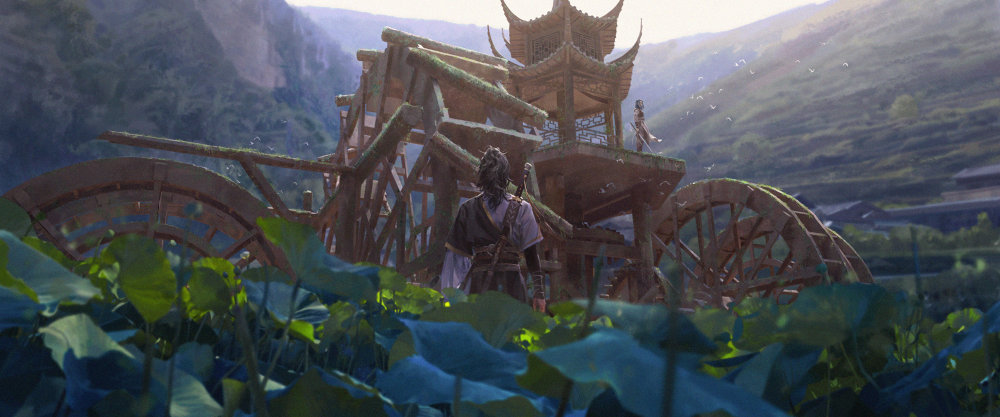
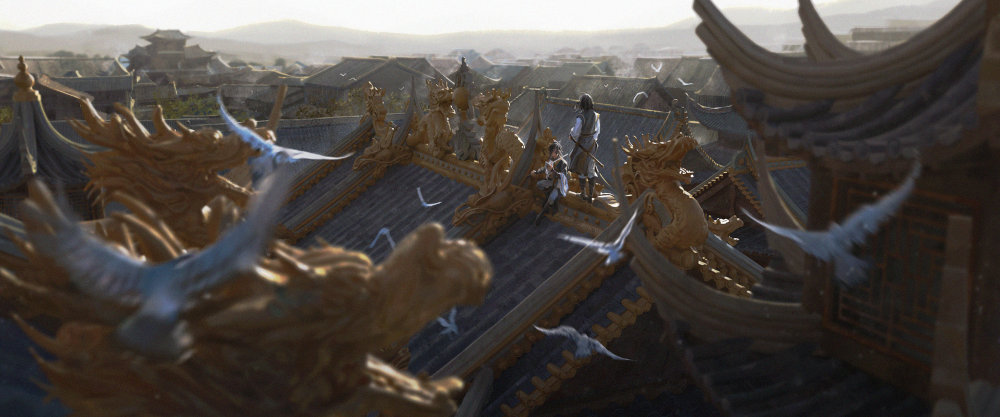
Having achieved your goal of working in an animation studio, I want to ask if you’ve got any advice for people with similar aims. What does an up-and-coming artist need to do to get their big break in this industry?
I’d encourage you to draw what you’re passionate about—it can make your portfolio stand out, and, more practically, drawing what you love means you’re naturally devoting more time and effort to your pieces. You’ll also likely be hired to draw the same type of work that exists in your portfolio, so it’s better for all parties that you enjoy your work (at least to some extent).
On that note, it’s really worthwhile to go out of your comfort zone—if the content in your portfolio is too specific or niche, it can be more challenging to land a job. Every show is unique in style and design, and since the duration of each show is just a few years, you’ll be jumping around quite a bit. Try a variety of subject matter and genres so that you can adapt to any show.
In terms of portfolio, I’d definitely suggest quality over quantity. Be patient with your pieces—take extra time to make a piece the best that you’re capable of or as close to your vision as possible, and only include work that you’re most proud of.
Another suggestion is to make sure your work is visible online. Almost every opportunity I’ve had so far has been because someone saw my work on my website or social media accounts. It’s beneficial if you didn’t go to art school and lack those industry connections—remote work and online networking are much more prevalent due to the pandemic, so it’s a good idea to take advantage of it!
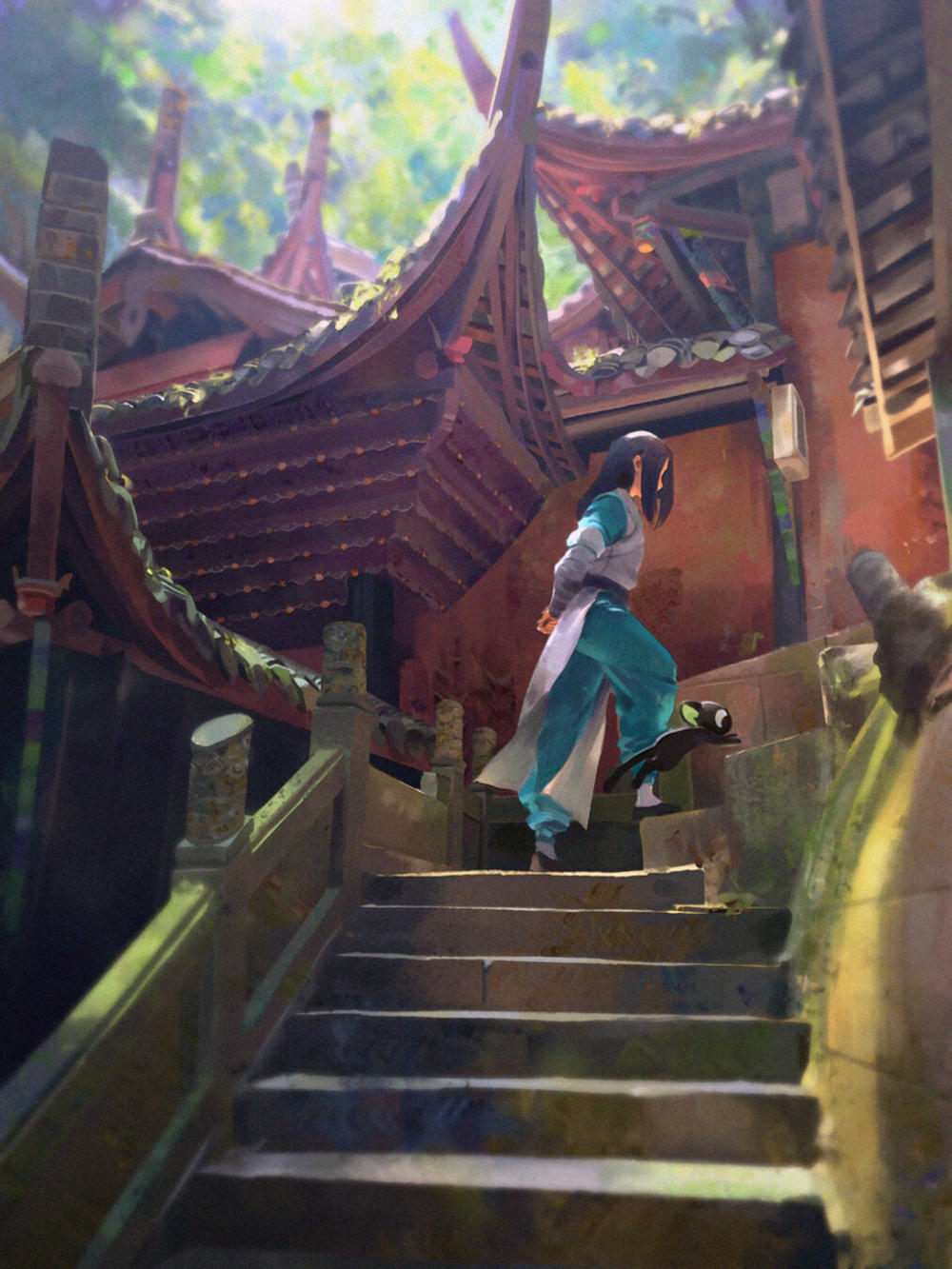
I’d love to learn a thing or two about your process! Do you think you could walk us through some of your favorite techniques?
For personal pieces, my process often starts with a genre, inspired by anything from a recently-finished show or novel to a favorite song or the numerous disorganized boards I keep on Pinterest.
I’ll make a line sketch for composition before blocking in color to establish lighting and mood. If the image involves complex perspective or architecture, I’ll model a rough scene in 3D, playing with camera angles and lighting to see if I can improve on the initial composition. I’ll render out a couple images and use them as a base to paint over in Photoshop.
From there, it’s just building up detail! I’ll usually go back and forth between painting in 2D and building/rendering in 3D, and throughout the whole process, I’m constantly looking up references. In the earlier stages, I’ll look for refs for the same type of lighting and environment as my painting. Later on, I’ll look for refs for specific objects or furnishings, whether for design inspiration or surfacing information.
Ideally, I like to take my own photo ref—I’m always on the lookout for interesting lighting situations or objects to snap for potential future ref, and many of the refs I’ve used for my nature-heavy pieces are from hiking trips.
Regarding favorite techniques, I like to use Gaussian blur on the foreground and background elements to mimic the depth of field. It really helps to solidify the focus and emphasize the cinematic feel of the piece.
Another favorite is a soft light layer at the end—I like to use the gradient tool with one color for the light and one for the shadow, and I’ll drag from the light source to the direction the light is facing. This can help balance the lighting as well as increase its intensity in the scene.

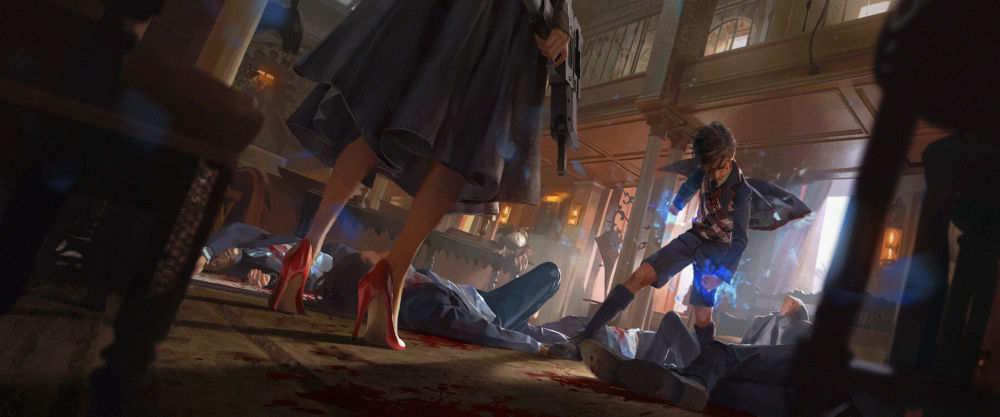
Now that we’ve touched on technique, I’d like to ask you about the kinds of stories you’re looking to tell. Animated films are a powerful way to communicate a message, so what’s yours?
I wouldn’t say I have any particular message! I just love the idea of places and characters and stories that don’t exist in our own world but are just real enough that they evoke feelings of nostalgia and longing. I’ll often experience these emotions overwhelmingly in other media, which motivates me to recreate or translate them in my own work. My approach to personal work is more intuitive rather than logical—my decisions are based mainly on whether or not the result makes me feel something.
There are always specific emotions I experience and aim for while working on each piece, but how a viewer feels will depend on their personal history or background. If a viewer sees any hint of a story in my work, my hope is that it becomes something personal and evocative for them.
What are some of your favorite films or series in the medium? I’m really just looking to find out what inspires you, so feel free to go all out with the recommendations!
My all-time favorite animated films are all a part of the How to Train Your Dragon trilogy! I watched the first one in middle school, and it was the first time I was really blown away by how a film made me feel—how thrilling the flying scenes were, how genuine the relationships between the characters felt, how I couldn’t stop imagining Toothless among the trees whenever I went hiking.
I’d say that same principle applies to other favorites—there has to be enough richness and depth so that the world feels within grasp, but enough is unsaid so that I can’t help wondering at the numerous other stories that could take place there.
Another one of my favorites is Gurren Lagann. I absolutely love how exaggerated its style (and the style of Studio Trigger) is and how unapologetically ludicrous the story gets. I guess Gurren Lagann doesn’t feel quite as “real” in the way the previous films I mentioned do, but that pure imagination and sheer scale of it are what inspire me—they’re literally hurling around galaxies in the final episode.
To list some other favorites: Avatar: The Last Airbender, Spirited Away, Wolf Children, and The Legend of Hei.
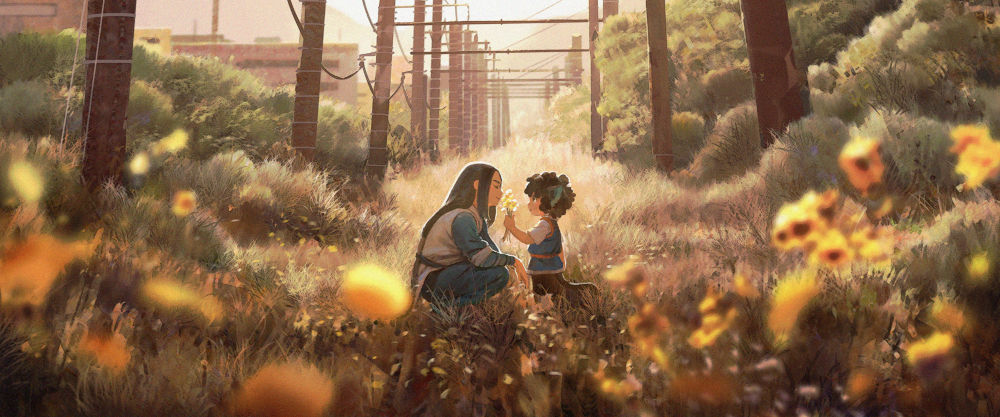
I recently discovered the piano covers on your site. Really relaxing stuff! Is music another big creative outlet for you alongside painting?
Yes! I think music, even more than art, evokes the most emotion. I have to listen to music when I’m drawing, especially for personal work, and I try to paint those feelings into my work. Playing music is also my go-to when I’m burnt out from art—letting my thoughts wander and emotions swell while I’m noodling around on guitar or piano helps me rest my mind and find motivation again.
I would love to make my own music, but that’s a field I’ve only touched the edges of, so for now, I settle with arranging covers of some of my favorite pieces!
What’s next for Aliya Chen?
I’m super excited about the projects I’m currently working on! In the future, I think I want to keep learning with each project and contributing to stories I’m passionate about. I also have several snippets of my own stories floating around in my head—maybe I’ll snag one someday and try to develop it into something tangible.
One thing I’ve definitely felt more strongly (both from researching different cultures on my projects and from the immobility of the pandemic) is the desire to travel. So much of my knowledge is secondhand, and I’d love to experience the world for myself and gather inspiration for future stories.
If you enjoy Aliya’s work, consider visiting her website or following her on Twitter.
Please donate to perephoneia.art if you liked this interview. Your support helps cover the hosting costs for the website, keeping it free and online for others to discover.
